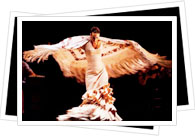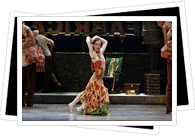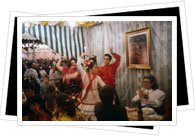
After suffering a decline in both popularity and practice, flamenco music and dance have come back with a fitting passion to the Spanish cultural forefront. Drawing musical elements from various eastern world cultures and fusing them later on with the Jewish and Arab cultures eventually yielded the musical artform and source of national - and in particular Andalucían - pride known as flamenco.
Still existing in its purest forms in the towns and city quarters of gypsy and refugee (from when the Catholic kings banned Jewish and Muslim religions) origin, particularly those along the Guadalquivir River, the essence of flamenco music continues to lie in the live performance. For this very reason, the art took shape, surfaced, and flourished in bars, parties, and tablaos.
 The typical flamenco performance is comprised of several crucial figures who push each other as they strive to evoke a response in the audience. The ability to do this, to achieve this intense emotional connection, is know as the duende (spirit). If you find yourself inadvertently on the edge of your seat with goosebumps down your arms and your mouth open wide in awe, you could say that the performers in front of you have succeeded.
The typical flamenco performance is comprised of several crucial figures who push each other as they strive to evoke a response in the audience. The ability to do this, to achieve this intense emotional connection, is know as the duende (spirit). If you find yourself inadvertently on the edge of your seat with goosebumps down your arms and your mouth open wide in awe, you could say that the performers in front of you have succeeded.
The singer, or cantaor, fiercely belts out an intensely passionate song of lament known as a cante jondo (deep song). The guitarist, or tocaor, improvises as he complements the strong voice of the cantaor and together they aim to achieve the highest possible level of intensity. Accompanying them and setting the atmosphere for the dancers and singers are people who clap their hands, shout to the other performers, snap their fingers, and stomp their feet, all of which is known as jaleo. Flamenco dancers, typically young women wearing brilliant dresses, perform with a feisty passion, spinning and drilling their heels into the floorboards with mind-blowing force.
Flamenco music also takes shape other forms, like sevillanas and saetas. Naturally, Sevilla remains the place to see flamenco and its variants, and you can do so in one of its numerous flamenco venues. Plus, be here in September for the month-long Bienal de Flamenco; it’s the most important flamenco festival in Spain and takes place every other year.
 Sevillanas
Sevillanas
The four-part songs – and accompanying dances - known as sevillanas originated in medieval Sevilla and consist of improvised verses accompanied by flamenco guitar and clacking castanets. To see these joyful sevillanas as they're meant to be seen, follow the locals to Sevilla's Feria de Abril and maybe they'll even teach you a few steps.
La Saeta
If you're lucky enough to be in Sevilla during its spectacular Semana Santa, you're sure to hear another manifestation of flamenco in the form of a saeta. This is essentially a sung prayer dedicated to the Virgins carried during the Semana Santa processions. The float pauses and a singer, usually perched on a balcony, spontaneously bursts into this short but powerful song. The crowds remain silent and the procession doesn't set back into motion until the singer finishes his or her saeta.